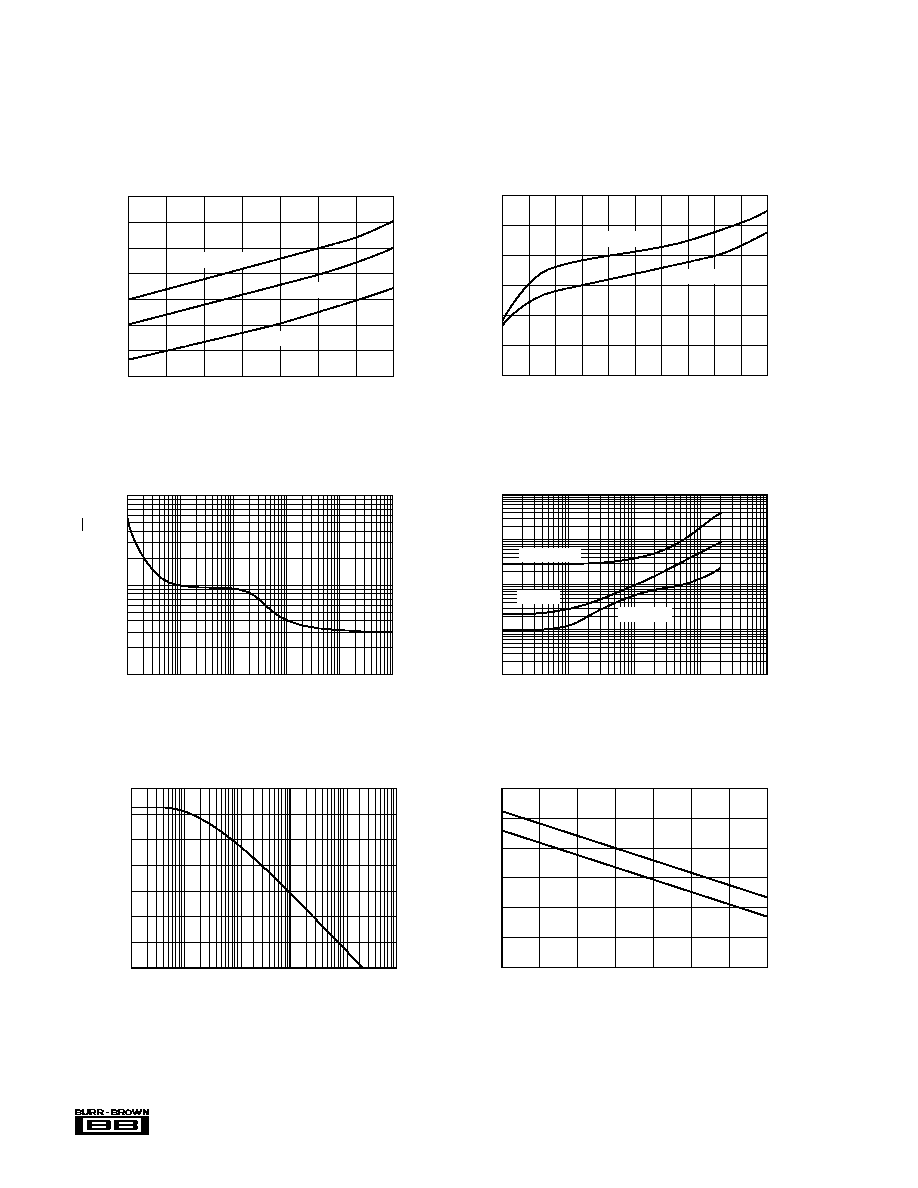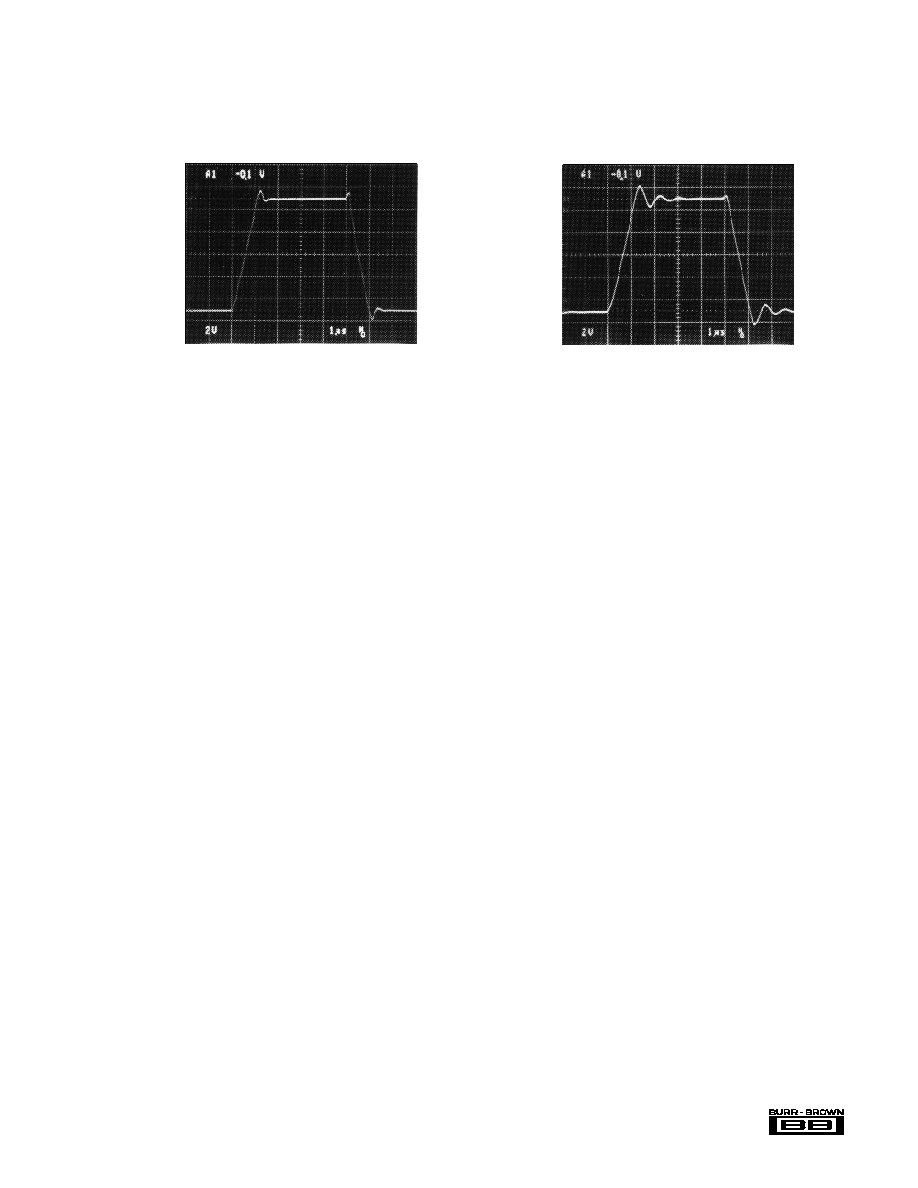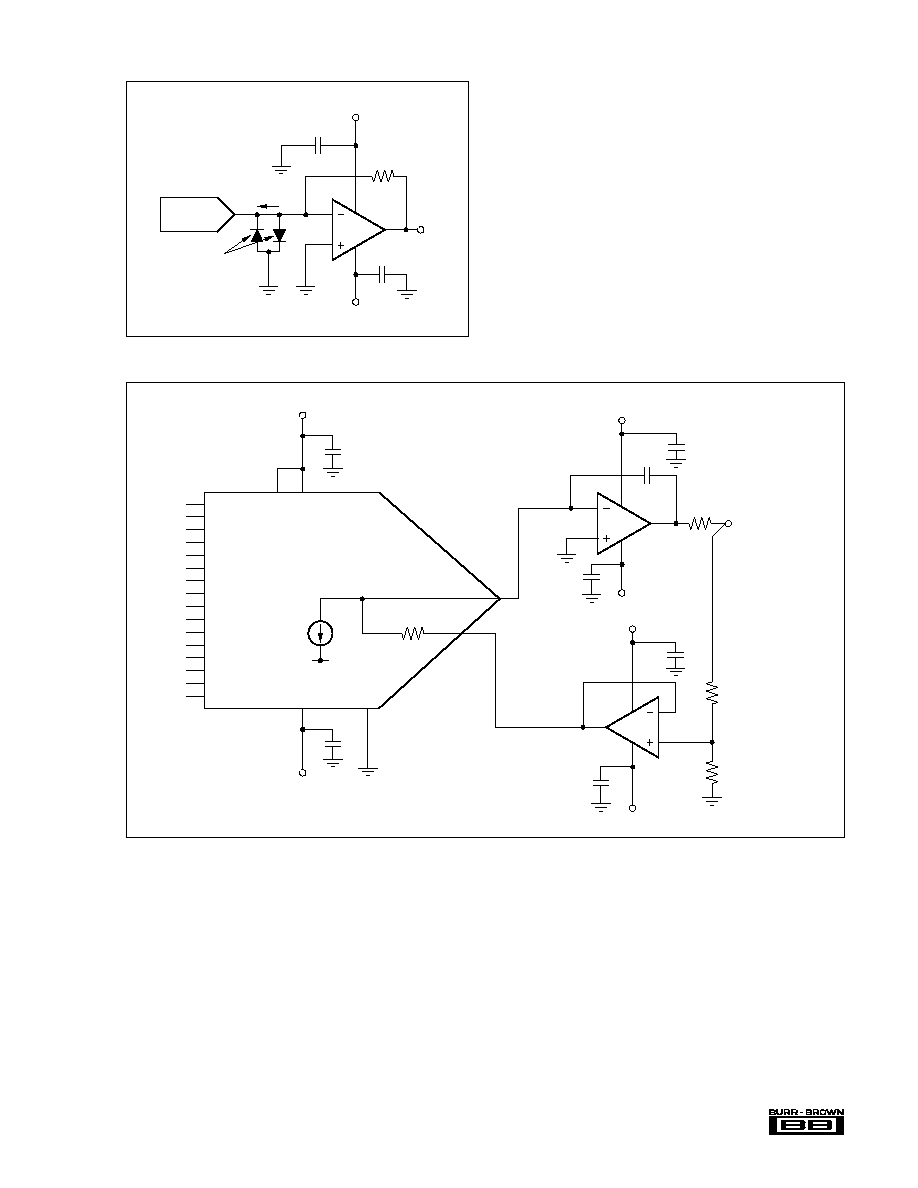
DESCRIPTION
The OPA2541 is a dual power operational amplifier
capable of operation from power supplies up to
±
40V
and output currents of 5A continuous. With two mono-
lithic power amplifiers in a single package it provides
unequaled functional density.
The industry-standard 8-pin TO-3 package is isolated
from all internal circuitry allowing it to be mounted
directly to a heat sink without insulators which de-
grade thermal performance. Internal circuitry limits
output current to approximately 6A.
The OPA2541 is available in both industrial and
military temperature range versions.
Dual High Power
OPERATIONAL AMPLIFIER
FEATURES
q
OUTPUT CURRENTS TO 5A
q
POWER SUPPLIES TO
±
40V
q
FET INPUT
q
ELECTRICALLY ISOLATED CASE
APPLICATIONS
q
MOTOR DRIVER
q
SERVO AMPLIFIER
q
SYNCRO/RESOLVER EXCITATION
q
VOICE COIL DRIVER
q
BRIDGE AMPLIFIER
q
PROGRAMMABLE POWER SUPPLY
q
AUDIO AMPLIFIER
OPA2541
Out
(5, 1)
≠V
S
(6)
+V
S
(2)
+In
(3, 7)
≠In
(4, 8)
Æ
International Airport Industrial Park ∑ Mailing Address: PO Box 11400 ∑ Tucson, AZ 85734 ∑ Street Address: 6730 S. Tucson Blvd. ∑ Tucson, AZ 85706
Tel: (520) 746-1111 ∑ Twx: 910-952-1111 ∑ Cable: BBRCORP ∑ Telex: 066-6491 ∑ FAX: (520) 889-1510 ∑ Immediate Product Info: (800) 548-6132
©
1987 Burr-Brown Corporation
PDS-768B
Printed in U.S.A. October, 1993
SBOS157

Æ
OPA2541
2
The information provided herein is believed to be reliable; however, BURR-BROWN assumes no responsibility for inaccuracies or omissions. BURR-BROWN assumes
no responsibility for the use of this information, and all use of such information shall be entirely at the user's own risk. Prices and specifications are subject to change
without notice. No patent rights or licenses to any of the circuits described herein are implied or granted to any third party. BURR-BROWN does not authorize or warrant
any BURR-BROWN product for use in life support devices and/or systems.
SPECIFICATIONS
ELECTRICAL
At T
C
= +25
∞
C and V
S
=
±
35VDC, unless otherwise noted.
OPA2541AM
OPA2541BM, SM
PARAMETER
CONDITIONS
MIN
TYP
MAX
MIN
TYP
MAX
UNITS
INPUT OFFSET VOLTAGE
V
OS
±
2
±
10
±
0.25
±
1
mV
vs Temperature
Specified Temperature Range
±
20
±
40
±
15
±
30
µ
V/
∞
C
vs Supply Voltage
V
S
=
±
10V to
±
V
MAX
±
2.5
±
10
*
*
µ
V/V
vs Power
±
20
±
60
*
*
µ
V/W
INPUT BIAS CURRENT
I
B
15
50
*
*
pA
Specified Temperature Range
Note 1
*
INPUT OFFSET CURRENT
I
OS
±
5
±
30
*
*
pA
Specified Temperature Range
Note 1
*
INPUT CHARACTERISTICS
Common-Mode Voltage Range
Specified Temperature Range
±
(|V
S
| ≠6)
±
(|V
S
| ≠3)
*
*
V
Common-Mode Rejection
V
CM
= (|
±
V
S
| ≠6V)
95
106
*
*
dB
Input Capacitance
5
*
pF
Input Impedance, DC
1
*
10
12
GAIN CHARACTERISTICS
Open Loop Gain at 10Hz
R
L
= 6
90
96
*
*
dB
Gain-Bandwidth Product
1.6
*
MHz
OUTPUT
Voltage Swing
I
O
= 5A
±
(|V
S
| ≠5.5)
±
(|V
S
| ≠4.5)
*
*
V
I
O
= 2A
±
(|V
S
| ≠4.5)
±
(|V
S
| ≠3.6)
*
*
V
I
O
= 0.5A
±
(|V
S
| ≠4)
±
(|V
S
| ≠3.2)
*
*
V
Current, Continuous
+25
∞
C
5
7.0
*
*
A
+85
∞
C
4
5.0
*
A
+125
∞
C (SM grade only)
3
3.5
A
AC PERFORMANCE
Slew Rate
6
8
*
*
V/
µ
s
Power Bandwidth
R
L
= 8
, V
O
= 20Vrms
45
55
*
*
kHz
Settling Time to 0.1%
2V Step
2
*
µ
s
Capacitive Load
Specified Temperature Range, G = 1
3.3
*
nF
Specified Temperature Range, G >10
SOA
*
Phase Margin
Specified Temperature Range, R
L
= 8
40
*
Degrees
Channel Separation
1kHz, R
L
= 6
80
*
dB
POWER SUPPLY
Power Supply Voltage,
±
V
S
Specified Temperature Range
±
10
±
30
±
35
*
±
35
±
40
V
Current, Quiescent
Total--Both Amplifiers
40
50
*
*
mA
THERMAL RESISTANCE
JC
, (Junction-to-Case)
Both Amplifiers
(2)
, AC Output f > 60Hz
0.8
1.0
*
*
∞
C/W
JC
Both Amplifiers
(2)
, DC Output
0.9
1.2
*
*
∞
C/W
JC
One Amplifier, AC Output f > 60Hz
1.25
1.5
*
*
∞
C/W
JC
One Amplifier, DC Output
1.4
1.9
*
*
∞
C/W
JA
, (Junction-to-Ambient)
No Heat Sink
30
*
∞
C/W
TEMPERATURE RANGE
Case
AM, BM
≠25
+85
*
*
∞
C
SM
≠55
+125
∞
C
*Specification same as OPA2541AM.
NOTES: (1) Input bias and offset current approximately doubles for every 10
∞
C increase in temperature. (2) Assumes equal dissipation in both amplifiers.

Æ
OPA2541
3
100
10
1
0.1
0.01
0.001
≠25
25
100
125
Junction Temperature (∞C)
INPUT BIAS CURRENT vs TEMPERATURE
Input Bias Current (nA)
0
50
75
TYPICAL PERFORMANCE CURVES
T
A
= +25
∞
C and V
S
=
±
35VDC, unless otherwise noted.
Supply Voltage, +V
S
to ≠V
S
.................................................................. 80V
Output Current ............................................................................. see SOA
Power Dissipation, Internal
(1)
............................................................ 125W
Input Voltage: Differential .....................................................................
±
V
S
Common-mode .............................................................
±
V
S
Temperature: Pin Solder, 10s ........................................................ +300
∞
C
Junction
(1)
............................................................... +150
∞
C
Temperature Range:
Storage .................................................... ≠65
∞
C to +150
∞
C
Operating (Case) ..................................... ≠55
∞
C to +125
∞
C
NOTE: (1) Long term operation at the maximum junction temperature will
result in reduced product life. Derate internal power dissipation to achieve
high MTTF.
ABSOLUTE MAXIMUM RATINGS
CONNECTION DIAGRAM
1
2
3
7
8
5
6
A
B
+V
S
+In
B
≠In
B
Out
B
≠V
S
Out
A
≠In
A
+In
A
4
ORDERING INFORMATION
PACKAGE INFORMATION
PACKAGE DRAWING
MODEL
PACKAGE
NUMBER
(1)
OPA2541AM
TO-3
030
OPA2541BM
TO-3
030
OPA2541SM
TO-3
030
NOTE: (1) For detailed drawing and dimension table, please see end of data
sheet, or Appendix D of Burr-Brown IC Data Book.
Top View
TO-3
MODEL
PACKAGE
TEMPERATURE RANGE
OPA2541AM
TO-3
≠25
∞
C to +85
∞
C
OPA2541BM
TO-3
≠25
∞
C to +85
∞
C
OPA2541SM
TO-3
≠55
∞
C to +125
∞
C
1
100
100k
10M
Frequency (Hz)
OPEN-LOOP GAIN AND PHASE vs FREQUENCY
10
1k
10k
1M
110
100
90
80
70
60
50
40
30
20
10
0
Voltage Gain (dB)
≠10
0
≠45
≠90
≠135
≠180
Phase (Degrees)
Z
L
= 3.3nF
Phase
Gain
Z
L
= 2k
Z
L
= 3.3nF
Z
L
= 2k

Æ
OPA2541
4
12
10
8
6
4
2
0
≠50
0
75
125
Case Temperature (∞C)
OUTPUT CURRENT vs TEMPERATURE
Output Current (A)
≠25
25
50
100
I
OUT
≠
I
OUT
+
120
110
100
90
80
70
60
50
10
100
100k
1M
Frequency (Hz)
COMMON-MODE REJECTION vs FREQUENCY
CMRR (dB)
1k
10k
10
1.0
0.1
0.01
0.001
10
100
10k
100k
Frequency (Hz)
TOTAL HARMONIC DISTORTION vs FREQUENCY
THD + Noise (%)
1k
P
O
= 5W
P
O
= 50W
P
O
= 100mW
1k
100
10
1
10
10k
100k
Frequency (Hz)
VOLTAGE NOISE DENSITY vs FREQUENCY
Voltage Noise Density (nV/
Hz)
100
1k
6
5
4
3
2
1
0
0
3
7
10
I
OUT
(A)
OUTPUT VOLTAGE SWING vs OUTPUT CURRENT
|±V
S
| ≠ |V
OUT
| (V)
1
4
5
9
2
6
8
|≠V
S
| ≠ |V
O
|
(+V
S
)
≠ V
O
1.3
1.2
1.1
1.0
0.9
0.8
0.7
0.6
20
40
70
90
+V
S
+ |≠V
S
| (V)
NORMALIZED QUIESCENT CURRENT
vs TOTAL POWER SUPPLY VOLTAGE
Normalized I
Q
30
50
60
80
T
C
= ≠25∞C
T
C
= +25∞C
T
C
= +125∞C
TYPICAL PERFORMANCE CURVES
(CONT)
T
A
= +25
∞
C and V
S
=
±
35VDC, unless otherwise noted.

Æ
OPA2541
5
Z
LOAD
=
, V
S
= ±35V, A
V
= +1
DYNAMIC RESPONSE
TYPICAL PERFORMANCE CURVES
(CONT)
T
A
= +25
∞
C and V
S
=
±
35VDC, unless otherwise noted.
pation (total of both amplifiers) times the appropriate ther-
mal resistance--
T
JC
= (P
D
total)
(
JC
).
Sufficient heat sinking must be provided to keep the case
temperature within safe limits for the maximum ambient
temperature and power dissipation. The thermal resistance
of the heat sink required may be calculated by:
HS
= (150
∞
C ≠
T
JC
≠ T
A
)/P
D
.
Commercially available heat sinks usually specify thermal
resistance. These ratings are often suspect, however, since
they depend greatly on the mounting environment and air
flow conditions. Actual thermal performance should be
verified by measurement of case temperature under the
required load and environmental conditions.
No insulating hardware is required when using the OPA2541.
Since mica and other similar insulators typically add
0.7
∞
C/W thermal resistance, this is a significant advantage.
See Burr-Brown Application Note AN-83 for further details
on heat sinking.
SAFE OPERATING AREA
The Safe Operating Area (SOA) curve provides comprehen-
sive information on the power handling abilities of the
OPA2541. It shows the allowable output current as a func-
tion of the voltage across the conducting output transistor
(see Figure 1). This voltage is equal to the power supply
voltage minus the output voltage. For example, as the
amplifier output swings near the positive power supply
voltage, the voltage across the output transistor decreases
and the device can safely provide large output currents
demanded by the load.
INSTALLATION
INSTRUCTIONS
POWER SUPPLIES
The OPA2541 is specified for operation from power sup-
plies up to
±
40V. It can also be operated from an unbalanced
or a single power supply so long as the total power supply
voltage does not exceed 80V (70V for "AM" grade). The
power supplies should be bypassed with low series imped-
ance capacitors such as ceramic or tantalum. These should
be located as near as practical to the amplifier's power
supply pins. Good power amplifier circuit layout is, in
general, like good high-frequency layout. Consider the path
of large power supply and output currents. Avoid routing
these connections near low-level input circuitry to avoid
waveform distortion and instability.
Signal dependent load current can modulate the power
supply voltage with inadequate power supply bypassing.
This can affect both amplifiers' outputs. Since the second
amplifier's signal may not be related to the first, this will
degrade the inherent channel separation of the OPA2541.
HEAT SINKING
Most applications will require a heat sink to prevent junction
temperatures from exceeding the 150
∞
C maximum rating.
The type of heat sink required will depend on the output
signals, power dissipation of each amplifier, and ambient
temperature. The thermal resistance from junction-to-case,
JC
, depends on how the power dissipation is distributed on
the amplifier die.
DC output concentrates the power dissipation in one output
transistor. AC output distributes the power dissipation equally
between the two output transistors and therefore has lower
thermal resistance. Similarly, the power dissipation may be
all in one amplifier (worst case) or equally distributed
between the two amplifiers (best case). Thermal resistances
are provided for each of these possibilities. The case-to-
junction temperature rise is the product of the power dissi-
Z
LOAD
= 4700pF, V
S
= ±35V, A
V
= +1
DYNAMIC RESPONSE

Æ
OPA2541
6
The internal current limit will not provide short-circuit
protection in most applications. When the amplifier output is
shorted to ground, the full power supply voltage is im-
pressed across the conducting output transistor. For in-
stance, with V
S
=
±
35V, a short circuit to ground would
impress 35V across the conducting power transistor. The
maximum safe output current at this voltage is 1.8A, so the
internal current limit would not protect the amplifier. The
unit-to-unit variation and temperature dependence of the
internal current limit suggest that it be used to handle
abnormal conditions and not activated in commonly encoun-
tered circuit operation.
Reactive, or EMF generating loads such as DC motors can
present demanding SOA requirements. With a purely reac-
tive load, output voltage current occurs when the output
voltage is zero and the voltage across the conducting transis-
tor is equal to the full power supply voltage. See Burr-
Brown Application Note AN-123 for further information on
evaluating SOA.
Applications with inductive or EMF-generating loads which
can produce "kick back" voltage surges to the amplifiers
should include clamp diodes from the output terminals to the
power supplies. These diodes should be chosen to limit the
peak amplifier output voltage surges to less than 2V beyond
the power supply rail voltage. Common 1A rated rectifier
diodes will suffice in most applications.
APPLICATIONS CIRCUITS
FIGURE 2. Clamping Output for EMF-Generating Loads.
0.1µF
0.1µF
+35V
≠35V
A
V
= 1 + R
2
/R
1
= 5
R
2
10k
R
1
2.5k
V
IN
30pF
0.5
V
O
FIGURE 3. Isolating Capacitive Loads.
FIGURE 1. Safe Operating Area.
0.1µF
L
10µF
0.1µF
10µF
+V
S
+
≠V
S
D
1
D
2
Inductive-
or EMF-
Generating
Load
D
1
≠ D
2
: IN4003
+
FIGURE 4. Paralleled Operation, Extended SOA.
A
V
= ≠R
2
/R
1
= ≠10
20pF
L
20pF
R
2
100k
R
1
10k
0.1
10k
0.1
B
Slave
A
Master
V
IN
10
1.0
0.1
1
100
|V
S
≠ V
OUT
| (V)
SAFE OPERATING AREA
|I
O
| (A)
10
T
C
= +25∞C
T
C
= +85∞C
T
C
= +125∞C
*Depending on temperature, maximum output may
be restricted by internal current limit. See output
current specifications and typical curves.
*

Æ
OPA2541
7
0.1µF
+60V
≠8V
25k
0.1µF
DAC80-CBI-I
0-2mA
V
O
0-50V
Protects DAC
During Slewing
FIGURE 5. Programmable Voltage Source.
FIGURE 6. 16-Bit Programmable Voltage Source.
100pF
0.5
10k
(1)
FB
1
2
3
4
5
6
7
8
9
10
11
12
13
14
15
16
19
1/2
OPA2541
V
OUT
= ≠30V to +30V
1µF
+
+
1µF
+
LSB
MSB
DAC702
±1mA
Digital Word Input
+
1µF
+
1µF
≠15V
20
18
23
+15V
17
21
10k
OPA27
2
3
7
4
6
≠15V
+15V
≠35V
1µF
+
+35V
1µF
NOTE: (1) TCR Tracking Resistors.
5k
(1)

Æ
OPA2541
8
FIGURE 8. Limiting Output Current.
FIGURE 7. Bridge Amplifier Motor-Speed Controller.
V
IN
L
+V
S
750mA Continuous
≠V
S
NOTE: (1) Midwest Components Inc. 288D01006
(1)
0.1
0.6
5k
5k
EMF
PMI MOD907
10k
10k
10k
25k
25k
25k
25k
+15V
≠15V
7
4
1
3
5
2
≠35V
+35V
Regulation
Adjust
V
IN
1/2
OPA2541
1/2
OPA2541
INA105KP
6
10k

PACKAGING INFORMATION
ORDERABLE DEVICE
STATUS(1)
PACKAGE TYPE
PACKAGE DRAWING
PINS
PACKAGE QTY
OPA2541AM
NRND
TO/SOT
LMF
8
18
OPA2541AM-BI
NRND
ZZ (BB)
ZZ030
8
OPA2541BM
NRND
TO/SOT
LMF
8
18
OPA2541SM
NRND
TO/SOT
LMF
8
18
OPA2541SMQ
NRND
TO/SOT
LMF
8
18
(1) The marketing status values are defined as follows:
ACTIVE: Product device recommended for new designs.
LIFEBUY: TI has announced that the device will be discontinued, and a lifetime-buy period is in effect.
NRND: Not recommended for new designs. Device is in production to support existing customers, but TI does not recommend using this part in
a new design.
PREVIEW: Device has been announced but is not in production. Samples may or may not be available.
OBSOLETE: TI has discontinued the production of the device.
PACKAGE OPTION ADDENDUM
www.ti.com
3-Oct-2003

IMPORTANT NOTICE
Texas Instruments Incorporated and its subsidiaries (TI) reserve the right to make corrections, modifications,
enhancements, improvements, and other changes to its products and services at any time and to discontinue
any product or service without notice. Customers should obtain the latest relevant information before placing
orders and should verify that such information is current and complete. All products are sold subject to TI's terms
and conditions of sale supplied at the time of order acknowledgment.
TI warrants performance of its hardware products to the specifications applicable at the time of sale in
accordance with TI's standard warranty. Testing and other quality control techniques are used to the extent TI
deems necessary to support this warranty. Except where mandated by government requirements, testing of all
parameters of each product is not necessarily performed.
TI assumes no liability for applications assistance or customer product design. Customers are responsible for
their products and applications using TI components. To minimize the risks associated with customer products
and applications, customers should provide adequate design and operating safeguards.
TI does not warrant or represent that any license, either express or implied, is granted under any TI patent right,
copyright, mask work right, or other TI intellectual property right relating to any combination, machine, or process
in which TI products or services are used. Information published by TI regarding third-party products or services
does not constitute a license from TI to use such products or services or a warranty or endorsement thereof.
Use of such information may require a license from a third party under the patents or other intellectual property
of the third party, or a license from TI under the patents or other intellectual property of TI.
Reproduction of information in TI data books or data sheets is permissible only if reproduction is without
alteration and is accompanied by all associated warranties, conditions, limitations, and notices. Reproduction
of this information with alteration is an unfair and deceptive business practice. TI is not responsible or liable for
such altered documentation.
Resale of TI products or services with statements different from or beyond the parameters stated by TI for that
product or service voids all express and any implied warranties for the associated TI product or service and
is an unfair and deceptive business practice. TI is not responsible or liable for any such statements.
Following are URLs where you can obtain information on other Texas Instruments products and application
solutions:
Products
Applications
Amplifiers
amplifier.ti.com
Audio
www.ti.com/audio
Data Converters
dataconverter.ti.com
Automotive
www.ti.com/automotive
DSP
dsp.ti.com
Broadband
www.ti.com/broadband
Interface
interface.ti.com
Digital Control
www.ti.com/digitalcontrol
Logic
logic.ti.com
Military
www.ti.com/military
Power Mgmt
power.ti.com
Optical Networking
www.ti.com/opticalnetwork
Microcontrollers
microcontroller.ti.com
Security
www.ti.com/security
Telephony
www.ti.com/telephony
Video & Imaging
www.ti.com/video
Wireless
www.ti.com/wireless
Mailing Address:
Texas Instruments
Post Office Box 655303 Dallas, Texas 75265
Copyright
2003, Texas Instruments Incorporated









